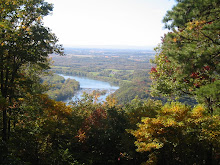
Monday, October 26th, 2009
3:45pm
When I walked out onto my balcony this morning, a layer of dry withered leaves covered the cement floor. Blown into corners and vulnerable to flight, these leaves were the remnants of my surrounding trees. The honey locust in front still glows with fluttering amber, but I am starting to see its naked limbs jutting out into the open blue sky. I watch the leaves shimmy over the cement floor; their delicate outlines quiver at the lightest breeze. Today, the light is warm and bright. The sun has been out all day, balanced with a fall wind that keeps my ankles chilled and my fingertips dry. I notice that when I spend time out on my balcony during the afternoon, I feel more alone. Rush hour has not yet arrived and most people are sitting in offices, watching the second hand. It’s not that I am lonely, but rather I feel like I am the only one who is enjoying this light at this time of the day. It casts a glow above the dead leaves at my toes, shadowing the vertical bars of the balcony. I feel safe enclosed in their lines.
I bought a few pumpkins at the Bloomfield Farmer’s Market last week. I put two on the table where I am typing. A medium-sized symmetrically round pumpkin with a tall stalk that twists up like old vines accompanies a smaller flatter cream-colored pumpkin with orange crevices and extruding round creases. My husband always makes fun of me for buying pumpkins every year. We don’t have a nice front porch to display them on, or even young kids that get kicks out of carving them. But it is something more than decorative for me. Since I was a child, I have always loved pumpkins: the way they look all bunched together, bleeding their orange-ness into one another, taking hay rides to the countryside’s patches and sorting through vines to get the perfect one, pulling out their slimy seeds with my sisters and baking them with salt, watching my dad take a knife to their flesh where he’d cut out their triangular eyes and sharp-toothed mouths. As a child, they were one of my favorite holiday props, completing the lure of fall festivities with squash soup and caramel apples, candy corn and Halloween.
Now that I’m older, I am much more aware of why and how I buy pumpkins. I’ve learned that the pumpkin industry is not necessarily good for the environment. Our consumer driven society has heightened the demand for pumpkins in order to fulfill that “fall festivity” I marveled at as a child. As a result, thousands of pumpkins are sold during the fall months, used for 1-8 weeks as decoration, and then dumped in a landfill where they take ages to decompose. In order to benefit most from pumpkins, I’ve learned that instead of dumping the pumpkins in the trash after the holiday, it is best to eat the insides (pumpkin soup and baked seeds), and/or plant the gourd under a lawn or garden. The rooting nutrients are very beneficial and healthy for the soil.
I read an article recently that suggested using pumpkins to clean up soil contaminated with DDT. Phytoremediation is the term used to describe plants that clean up contaminated soil (just like the brown field sites in Pittsburgh that are being cleaned up with sunflowers.) Canadian scientists found that pumpkins “sucked” up the most DDT and in some cases, PCB’s as well. It made me feel better about my love of pumpkins and my need to have them to look at, eat and carve every October.
The light has shifted slightly as I sit out here on my balcony. My thoughts of pumpkins and the environment have diverted me from watching the small world around me. Though smells of burning brush and drying pine fill my senses, I must go inside to warm my body and mind. Fall will still be here tomorrow.
